Human Orbital Spaceflights
![]()
International Flight No. 1VostokKedrUSSR |
 |
![]()
Launch, orbit and landing data
walkout photo |
 |
|||||||||||||||||||
alternative photo |
alternative photo |
|||||||||||||||||||
alternative photo |
||||||||||||||||||||
alternative photo |
||||||||||||||||||||
Crew
| No. | Surname | Given names | Position | Flight No. | Duration | Orbits | |
| 1 | Gagarin | Yuri Alekseyevich | Pilot Cosmonaut | 1 | 1h 46m ??s | 1 |
Crew seating arrangement
|
 |
1st Backup Crew
|
 |
||||||||||
2nd Backup Crew
|
 |
Hardware
| Launch vehicle: | Vostok Ye10316 |
| Spacecraft: | Vostok (3A 3KA Nr. 3) |
Flight
|
This mission was the first human orbital
spaceflight ever. Launch from the Baikonur Cosmodrome; landing of Yuri
Gagarin near Smelovka north of Usmorye (26 km southwest of
Engels); the empty spacecraft landed at 07:48
UTC. 27-year-old Yuri Gagarin was the only crew member of Vostok. The Vostok spacecraft was designed to carry a single cosmonaut. The primary and secondary backup cosmonauts for the mission were German Titov and Grigori Nelyubov. The assignments were formally made on April 08, 1961, four days before the mission, but Yuri Gagarin had been a favorite among the cosmonaut candidates for at least several months. The entire mission would be controlled by either automatic systems, or by ground control. This was because medical staff and spacecraft engineers were unsure how a human might react to weightlessness, and therefore it was decided to lock the pilot's manual controls. In an unusual move, a code to unlock the controls was placed in an onboard envelope, for Yuri Gagarin's use in case of emergency. But prior to the flight, Kamanin told Yuri Gagarin the code anyway. At 05:30 am Moscow time, on the morning of April 12, 1961, both Yuri Gagarin and his backup German Titov were woken. They were given breakfast, assisted into their spacesuits, and then were transported to the launch pad. Yuri Gagarin entered the Vostok spacecraft, and at 07:10 am local time (04:10 UTC), the radio communication system was turned on. Once Yuri Gagarin was in the Vostok spacecraft, his picture appeared on television screens in the launch control room from an onboard camera. Launch would not occur for another two hours, and during the time Yuri Gagarin chatted with the mission's main CapCom, as well as Chief Designer Sergei Korolev, Nikolai Kamanin, and a few others. Following a series of tests and checks, about forty minutes after Yuri Gagarin entered the spacecraft, its hatch was closed. It was soon discovered that the seal was not complete, so technicians spent nearly an hour removing all the screws and sealing the hatch again. Launch occurred from the Baikonur Cosmodrome Site No.1. Two minutes into the flight and the four strap-on booster sections of the Vostok rocket have used up the last of their propellant; they shut down and drop away from the core vehicle. Five minutes into the flight and the Vostok rocket core stage has used up its propellant, shuts down and falls away from the Vostok spacecraft and final rocket stage. The final rocket stage ignites to continue the journey to orbit. Three minutes into the burn of the final rocket stage and Yuri Gagarin reports, "Zarya-1, Zarya-1, I can't hear you very well. I feel fine. I'm in good spirits. I'm continuing the flight..." Vostok is moving further downrange from the Baikonur Cosmodrome. He is reporting back to Zarya-1 (the Baikonur ground station) and must be starting to move out of radio range of that station. Two minutes later the Vostok rocket final stage shuts down, ten seconds later the spacecraft separates and Vostok reaches orbit At 07:25 UTC, the spacecraft's automatic systems brought it into the required attitude (orientation) for the reentry engine firing, and shortly afterwards, the engine firing occurred, also known as retrofire. This took place over the west coast of Africa, near Angola, about 8,000 km (5,000 mi) from the desired landing point. The liquid-fueled retrorockets fired for about 42 seconds. Ten seconds after retrofire, commands were sent to separate the Vostok service module from the reentry module (sharik), but the Vostok equipment module unexpectedly remained attached to the reentry module by a bundle of wires. At around 07:35 UTC, the two halves of the spacecraft begin reentry and went through strong gyrations as Vostok neared Egypt. At this point the wires broke, the two modules separated, and the descent module settled into the proper reentry attitude. Yuri Gagarin telegraphed "Everything is OK" despite continuing gyrations; he later reported that he did not want to "make noise" as he had (correctly) reasoned that the gyrations did not endanger the mission (and were apparently caused by the spherical shape of the reentry module). As Yuri Gagarin continued his descent, he experienced about 8 g (Yuri Gagarin's own report states "over 10 g") during reentry but remained conscious. In case of reentry engine malfunction, the spacecraft was designed to descend within 10 days due to orbital decay. However, the actual orbit differed from the planned and would not have allowed descent until 20 days postlaunch while the life support system was designed to function for only 10 days. When Vostok was still 7 km from the ground, the hatch of the spacecraft was released, and two seconds later Yuri Gagarin was ejected. At 2.5 km (8,200 ft) altitude, the main parachute was deployed from the Vostok spacecraft. Two schoolgirls witnessed the Vostok landing and described the scene: "It was a huge ball, about two or three meters high. It fell, then it bounced and then it fell again. There was a huge hole where it hit the first time." Yuri Gagarin's parachute opened almost right away, and about ten minutes later, at 07:53 UTC, Yuri Gagarin landed. |
Photos / Graphics
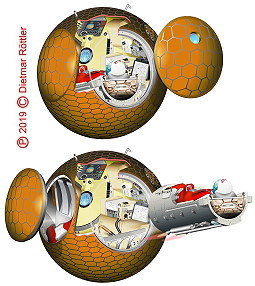 |
 |
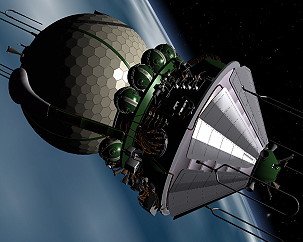 |
 |
 |
 |
 |
 |
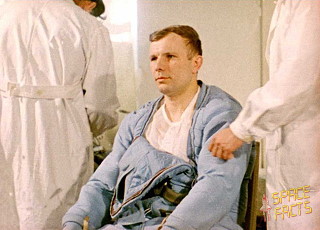 |
 |
 |
 |
 |
 |
 |
 |
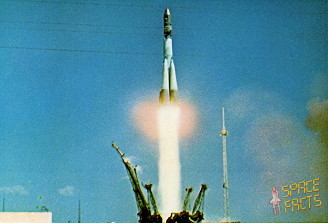 |
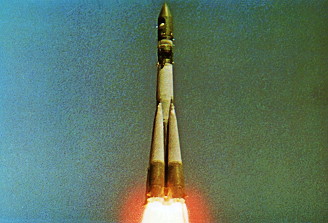 |
 |
 |
| © |  |
Last update on August 11, 2020.  |
 |